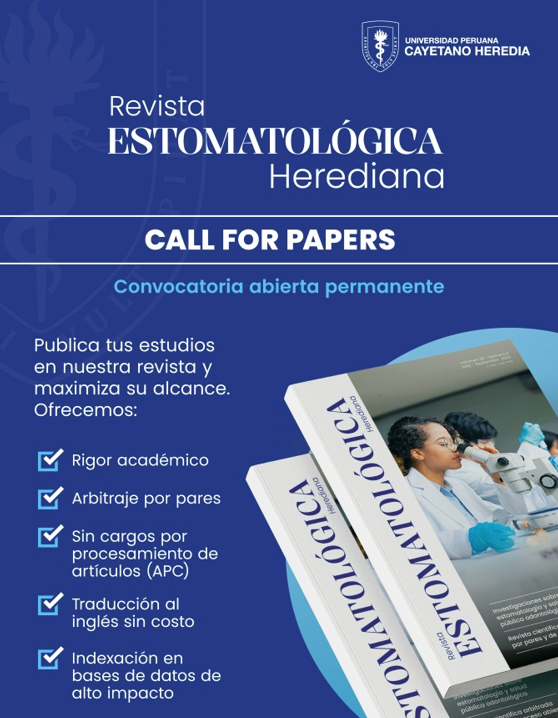Factores asociados a la pérdida sanguínea en cirugía ortognática.
DOI:
https://doi.org/10.20453/reh.v32i3.4278Palabras clave:
Pérdida sanguínea, tiempo quirúrgico, cirugía ortognáticaResumen
La cirugía ortognática (CO) es un procedimiento quirúrgico que genera pérdida sanguínea intraoperatoria (PSI), motivo por el cual el cirujano bucal y maxilofacial (CBMF) permanentemente está generando nuevas técnicas para controlarla. Objetivo: Determinar los factores asociados a la PSI en CO. Material y Métodos: Estudio retrospectivo, descriptivo transversal y analítico. Se revisaron 60 historias clínicas de pacientes operados de CO que cumplieron los criterios de selección. La variable dependiente fue PSI y las covariables: tipo de CO, operador (Cirujano bucal y Maxilofacial o Residente del programa en CBMF), instrumentos de corte, tiempo operatorio (TO), tiempo de protrombina (TP), tiempo de tromboplastina (TTP), recuento de plaquetas, edad y sexo. Se aplicaron las pruebas estadísticas ANOVA, t de Student, Rho de Spearman y correlación de Pearson. Resultados: Existe asociación estadísticamente significativa entre la PSI con el TO y la relación con el operador (p<0,005) y (p<0,001). Además, existe correlación directa entre PSI y TO (p<0,05). Conclusiones: El operador y el TO son variables asociadas directamente a la PSI en las CO.
Descargas
Citas
Gunson MJ, Arnett GW. Orthognathic virtual treatment planning for functional esthetic results. Semin Orthod. 2019;25(3):230–47.
Ferreira R. Manual de hemoterapia. Lima,Perú: MINSA;2015.p.1–29.
Song G, Yang P, Hu J, Zhu S, Li Y, Wang Q. The effect of tranexamic acid on blood loss in orthognathic surgery: A meta-analysis of randomized controlled trials. Oral Surg Oral Med Oral Pathol Oral Radiol. 2013;115(5):595–600.
Bell WH, Mannai C, Luhr HG: Art and science of the Le Fort I down fracture. Int J Adult Orthodon Orthognath Surg.1988;3: 23-52.
Trauner R, Obwegeser H. Zur Operationstechnik Bei der Progenie und anderen Unterkieferanomalien. Dtsch Zahn-Mund-Kieferheilk .1955;23:1-26.
Wolford LM, Bennett MA, Rafferty CG. Modification of the mandibular ramus sagittal split osteotomy. Oral Surg Oral Med Oral Pathol. 1987; 64(2):146–55.
Ferretti C, Mfos M, Sa FCD, Reyneke JP, Sa F. Genioplasty Chin deformity. Genioplasty technique. 2016; 24:79–85.
Cataneo DC. How is a surgeon’s experience measured? J Thorac Cardiovasc Surg. 2015; 149(4): 998-1004.
Thastum M, Andersen K, Rude K, Nørholt SE, Blomlöf J. Factors influencing intraoperative blood loss in orthognathic surgery. Int J Oral Maxillofac Surg. 2016; 45(9): 1070–1073.
Jeong J, Portnof JE, Kalayeh M, Hardigan P. Hypotensive anesthesia: Comparing the effects of different drug combinations on mean arterial pressure, estimated blood loss, and surgery time in orthognathic surgery. J Cranio-Maxillofacial Surg. 2016; 44(7):854–8.
Lanigan DT, Hey JH, West RA. Major vascular complications of orthognathic surgery: Hemorrhage associated with Le Fort I osteotomies. J Oral Maxillofac Surg. 1990; 48(6):561–573.
Dolman RM, Bentley KC, Head TW, English M. The effect of hypotensive anesthesia on blood loss and operative time during Le Fort I osteotomies. J Oral Maxillofac Surg. 2000; 58(8): 834–9.
Posnick JC, Choi E, Chavda A. Operative time, airway management, need for blood transfusions, and in-hospital stay for bimaxillary, intranasal, and osseous genioplasty surgery: Current clinical practices. J Oral Maxillofac Surg. 2016;74(3):590–600.
Samman N, Cheung LK, Tong a C, Tideman H. Blood loss and transfusion requirements in orthognatic surgery. J Oral Maxillofac Surg. 1996;54(1):21-4.
Stehrer R, Hingsammer L, Staudigl C, et al. Machine learning based prediction of perioperative blood loss in orthognathic surgery. J Cranio-Maxillofacial Surg. 2019; 47(11): 1676–81.
Andersen K, Thastum M, Nørholt SE, Blomlöf J. Relative blood loss and operative time can predict length of stay following orthognathic surgery. Int J Oral Maxillofac Surg. 2016; 45(10):1209–12.
Chen YA, Rivera-Serrano CM, Chen C, Chen YR. Pre-surgical regional blocks in orthognathic surgery: Prospective study evaluating their influence on the intraoperative use of anaesthetics and blood pressure control. Int J Oral Maxillofac Surg. 2016;45(6):783–6.
Rossi D, Romano M, Karanxha L, et al. Bimaxillary orthognathic surgery with a conventional saw compared with the piezoelectric technique: a longitudinal clinical study. Br J Oral Maxillofac Surg. 2018;56(8):698–704.
Descargas
Publicado
Cómo citar
Número
Sección
Licencia
Los autores conservan los derechos de autor y ceden a la revista el derecho de primera publicación, con el trabajo registrado con la Licencia de Creative Commons, que permite a terceros utilizar lo publicado siempre que mencionen la autoría del trabajo, y a la primera publicación en esta revista.























